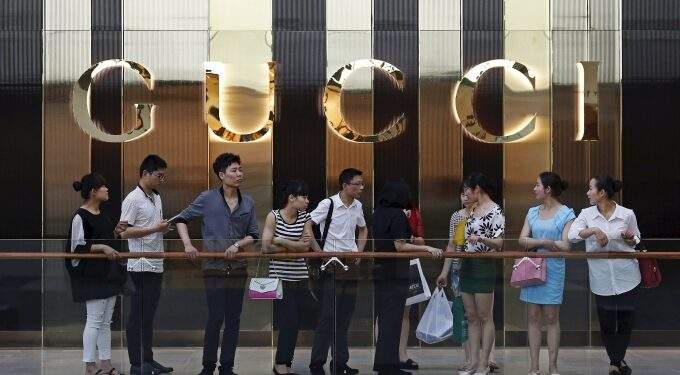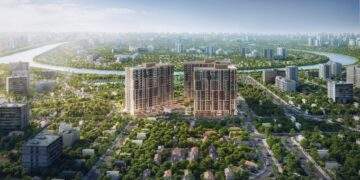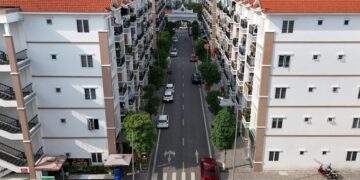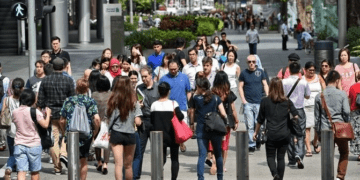That would mark a 7% increase from last year, putting Singapore ahead of regional rivals like Japan, China, and South Korea, Bloomberg reported, citing data from analytics firm Euromonitor International.
It would also put the city-state on track to return to its pre-pandemic peak of S$14.7 billion in 2026. Last year, its year-on-year growth in luxury sales was second only to Japan among the countries tracked by the firm.
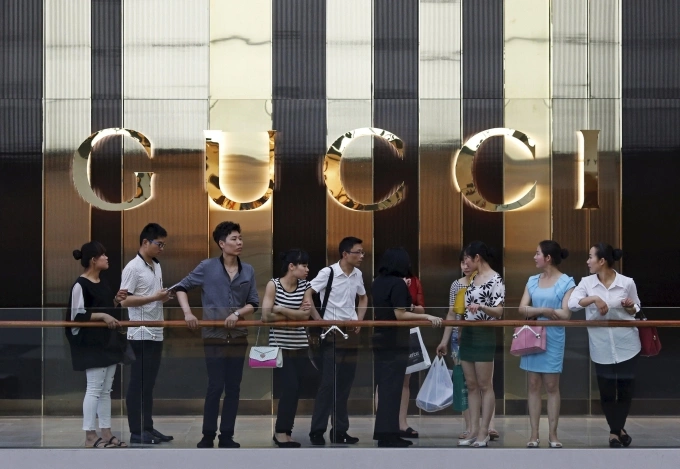 |
|
Tourists ask for directions outside a Gucci shop at the Marina Bay Sands mall in Singapore, April 24, 2015. Photo by Reuters |
As demand rises across all luxury segments, brands are stepping up their presence to stand out in Singapore’s competitive landscape. French jeweler Van Cleef & Arpels set up a boutique and exhibition space called Les Jardins Secrets at the Raffles Singapore hotel last February, as reported by the Financial Times.
Luxury watchmaker Audemars Piguet followed in January with AP House, its first Southeast Asia flagship at the same hotel, styled like a luxury apartment. The site also features the brand’s first-ever café, blending Swiss cuisine with local flair.
Meanwhile, Raffles City mall began making a strong push into the luxury beauty scene by hosting large pop-up events, featuring 21 brands this year, among them Chanel, Dior, and Gucci.
Though Singapore spans just 280 square miles and has a population of around six million, far smaller than Asian megacities such as Tokyo or Shanghai, it ranked third in luxury store openings last year among 32 Asia-Pacific cities outside mainland China, according to real estate firm Savills.
Singapore’s stability and business-friendly policies appeal to affluent individuals and luxury brands. Its long-standing openness to wealth and talent has helped it evolve into one of the world’s richest nations.
According to the World’s Wealthiest Cities Report 2025 by consultancy Henley & Partners, the country ranked as the fourth wealthiest city globally with 242,400 millionaire residents, including 333 centi-millionaires and 30 billionaires.
Median household employment income has also risen for five consecutive years while tourism spending is also on the rise.
International visitors spent S$3.9 billion on shopping from January to September 2024, up 5% from a year ago, according to The Straits Times.
These factors have made the city-state a hub for global high-end brands, offering them both a strong base and a springboard into the Southeast Asian market. At a time when China’s slowdown is weighing on the global luxury market, the city-state offers a rare bright spot.
“Singapore has proved to be a very stable place for wealthy people,” Jonathan Siboni, founder and CEO of consultancy Luxurynsight, said.
“That has created a very strong local base for the luxury market. Singapore is an oasis in the desert.”
Still, the city-state’s luxury market could soon face some challenges. Henley & Partners recently projected a net inflow of 1,600 millionaires to the city-state in 2025, less than half of the previous year’s figure, despite a record number of wealthy individuals expected to relocate globally, The Business Times reported.
And while Singapore ranked fifth among alpha cities worldwide for new luxury store openings, future expansion could be constrained, according to a recent report by Savills.
“The available real estate for luxury brands remains limited, which could somewhat limit the growth and expansion of luxury brands in the city in the near future,” said Sulian Tan-Wijaya, executive director of Retail & Lifestyle at Savills Singapore, as quoted by Singapore Business Review.
For now, the luxury surge is resonating with local consumers. Among them is 22-year-old Chloe Liem, who collects fine jewelry from brands such as Van Cleef & Arpels and Cartier.
“Even though I know luxury items are crazily marked up, I understand I’m paying for the experience and feeling of the brand,” Liem said. “I feel confident splurging on these items because I enjoy it.”

